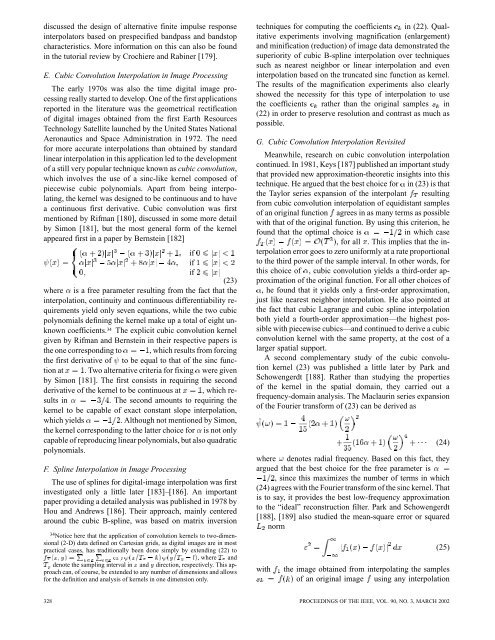from ancient astronomy to modern signal and image processing
from ancient astronomy to modern signal and image processing
from ancient astronomy to modern signal and image processing
Create successful ePaper yourself
Turn your PDF publications into a flip-book with our unique Google optimized e-Paper software.
discussed the design of alternative finite impulse responseinterpola<strong>to</strong>rs based on prespecified b<strong>and</strong>pass <strong>and</strong> b<strong>and</strong>s<strong>to</strong>pcharacteristics. More information on this can also be foundin the tu<strong>to</strong>rial review by Crochiere <strong>and</strong> Rabiner [179].E. Cubic Convolution Interpolation in Image ProcessingThe early 1970s was also the time digital <strong>image</strong> <strong>processing</strong>really started <strong>to</strong> develop. One of the first applicationsreported in the literature was the geometrical rectificationof digital <strong>image</strong>s obtained <strong>from</strong> the first Earth ResourcesTechnology Satellite launched by the United States NationalAeronautics <strong>and</strong> Space Administration in 1972. The needfor more accurate interpolations than obtained by st<strong>and</strong>ardlinear interpolation in this application led <strong>to</strong> the developmen<strong>to</strong>f a still very popular technique known as cubic convolution,which involves the use of a sinc-like kernel composed ofpiecewise cubic polynomials. Apart <strong>from</strong> being interpolating,the kernel was designed <strong>to</strong> be continuous <strong>and</strong> <strong>to</strong> havea continuous first derivative. Cubic convolution was firstmentioned by Rifman [180], discussed in some more detailby Simon [181], but the most general form of the kernelappeared first in a paper by Bernstein [182]ififif(23)where is a free parameter resulting <strong>from</strong> the fact that theinterpolation, continuity <strong>and</strong> continuous differentiability requirementsyield only seven equations, while the two cubicpolynomials defining the kernel make up a <strong>to</strong>tal of eight unknowncoefficients. 34 The explicit cubic convolution kernelgiven by Rifman <strong>and</strong> Bernstein in their respective papers isthe one corresponding <strong>to</strong> , which results <strong>from</strong> forcingthe first derivative of <strong>to</strong> be equal <strong>to</strong> that of the sinc functionat . Two alternative criteria for fixing were givenby Simon [181]. The first consists in requiring the secondderivative of the kernel <strong>to</strong> be continuous at , which resultsin. The second amounts <strong>to</strong> requiring thekernel <strong>to</strong> be capable of exact constant slope interpolation,which yields . Although not mentioned by Simon,the kernel corresponding <strong>to</strong> the latter choice for is not onlycapable of reproducing linear polynomials, but also quadraticpolynomials.F. Spline Interpolation in Image ProcessingThe use of splines for digital-<strong>image</strong> interpolation was firstinvestigated only a little later [183]–[186]. An importantpaper providing a detailed analysis was published in 1978 byHou <strong>and</strong> Andrews [186]. Their approach, mainly centeredaround the cubic B-spline, was based on matrix inversion34 Notice here that the application of convolution kernels <strong>to</strong> two-dimensional(2-D) data defined on Cartesian grids, as digital <strong>image</strong>s are in mostpractical cases, has traditionally been done simply by extending (22) <strong>to</strong>f (x; y)= c '(x=T 0 k) '(y=T 0 l), where T <strong>and</strong>T denote the sampling interval in x <strong>and</strong> y direction, respectively. This approachcan, of course, be extended <strong>to</strong> any number of dimensions <strong>and</strong> allowsfor the definition <strong>and</strong> analysis of kernels in one dimension only.techniques for computing the coefficients in (22). Qualitativeexperiments involving magnification (enlargement)<strong>and</strong> minification (reduction) of <strong>image</strong> data demonstrated thesuperiority of cubic B-spline interpolation over techniquessuch as nearest neighbor or linear interpolation <strong>and</strong> eveninterpolation based on the truncated sinc function as kernel.The results of the magnification experiments also clearlyshowed the necessity for this type of interpolation <strong>to</strong> usethe coefficients rather than the original samples in(22) in order <strong>to</strong> preserve resolution <strong>and</strong> contrast as much aspossible.G. Cubic Convolution Interpolation RevisitedMeanwhile, research on cubic convolution interpolationcontinued. In 1981, Keys [187] published an important studythat provided new approximation-theoretic insights in<strong>to</strong> thistechnique. He argued that the best choice for in (23) is thatthe Taylor series expansion of the interpolant resulting<strong>from</strong> cubic convolution interpolation of equidistant samplesof an original function agrees in as many terms as possiblewith that of the original function. By using this criterion, hefound that the optimal choice isin which case, for all . This implies that the interpolationerror goes <strong>to</strong> zero uniformly at a rate proportional<strong>to</strong> the third power of the sample interval. In other words, forthis choice of , cubic convolution yields a third-order approximationof the original function. For all other choices of, he found that it yields only a first-order approximation,just like nearest neighbor interpolation. He also pointed atthe fact that cubic Lagrange <strong>and</strong> cubic spline interpolationboth yield a fourth-order approximation—the highest possiblewith piecewise cubics—<strong>and</strong> continued <strong>to</strong> derive a cubicconvolution kernel with the same property, at the cost of alarger spatial support.A second complementary study of the cubic convolutionkernel (23) was published a little later by Park <strong>and</strong>Schowengerdt [188]. Rather than studying the propertiesof the kernel in the spatial domain, they carried out afrequency-domain analysis. The Maclaurin series expansionof the Fourier transform of (23) can be derived as(24)where denotes radial frequency. Based on this fact, theyargued that the best choice for the free parameter is, since this maximizes the number of terms in which(24) agrees with the Fourier transform of the sinc kernel. Thatis <strong>to</strong> say, it provides the best low-frequency approximation<strong>to</strong> the “ideal” reconstruction filter. Park <strong>and</strong> Schowengerdt[188], [189] also studied the mean-square error or squarednormwith(25)the <strong>image</strong> obtained <strong>from</strong> interpolating the samplesof an original <strong>image</strong> using any interpolation328 PROCEEDINGS OF THE IEEE, VOL. 90, NO. 3, MARCH 2002
















